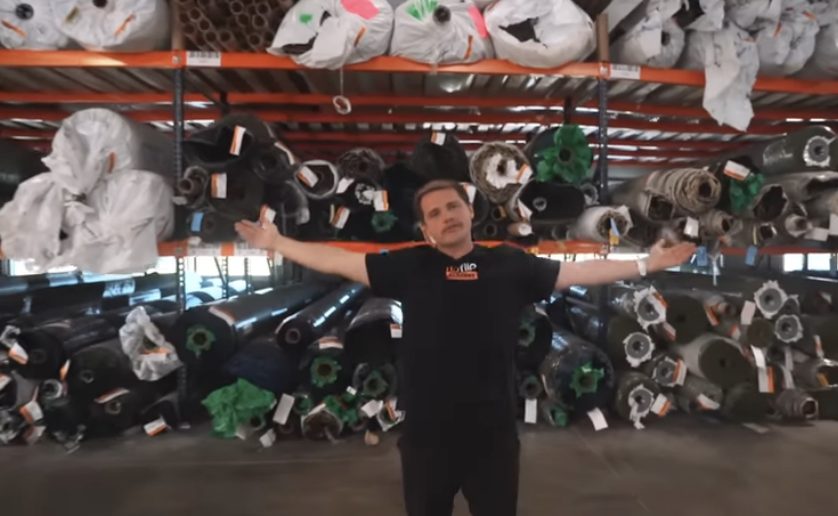After a terrifying car accident on a snowy highway, Upflip knew his corporate life had to change. Spinning off the road and crashing through a fence at 6:30 AM while rushing to a surgery appointment was their wake-up call. When the doctor called, there was no concern for their well-being—just pressure about how quickly they could still reach the hospital.
That moment crystallized everything wrong with their career path. He had abandoned entrepreneurship for the supposed security of corporate America, only to find himself risking his life on icy roads while missing precious time with his family.
The irony? He had already built a successful artificial turf business years earlier, but sold his ownership stake to chase what he thought was the “dream” corporate lifestyle. Sometimes the best business opportunity is the one you’ve already discovered but didn’t fully appreciate.
From Corporate Burnout to $2 Million in Turf
With only $10,000 to my name, I quit my corporate job the same month I got married (not recommended!) and launched Waterloo Turf. The first year, we generated $400,000 in revenue in Austin. Fast forward to today, and we’re doing over $2 million annually between our Austin and San Antonio locations.
What’s remarkable is that we’re achieving these numbers while spending just $5,000 monthly on advertising. The secret? An old-school approach that costs about $3 per prospect but delivers consistent results.
While everyone else obsesses over digital clicks and conversion rates, we’ve found that the most powerful marketing tool is actually:
- Building face-to-face relationships with potential commercial partners
- Dropping off coffee and donuts to establish personal connections
- Creating 7-10 new commercial relationships every day during the first 90 days
- Following up consistently—we recommend seven follow-ups per prospect
This approach might seem quaint in today’s digital-first world, but the results speak for themselves. When you take the time to build real relationships, those connections become your sales force.
The Turf Business Advantage
Artificial turf offers unique advantages as a business model. Unlike many home improvements that go unnoticed, turf installations get immediate attention and generate conversations. When friends visit a home with new turf, they invariably ask, “Who did this for you?”
The business also benefits from strong economics. A typical installation might require 20 yards of limestone base material (about $1,000) plus the turf itself. With proper systems in place, crews can complete most residential installations in just two days.
The ROI for customers is compelling, too. While many perceive turf as expensive, the investment typically pays for itself within five years when compared to the costs of traditional lawn maintenance. Adding water conservation benefits makes it an easy sell in many markets.
I spun off the road and flew through that fence, and it was about at that point that I knew that it was over. I ended up quitting my job the same month that I got married. So, yeah. You could say the stakes couldn’t have been higher.
Building Systems That Scale
The key to growing from $400,000 to $2 million wasn’t working harder—it was building better systems. I maintain a strict 8-to-5 workday because I believe entrepreneurs don’t need to work 90-hour weeks to succeed.
The real secret is making every day feel like Groundhog Day—creating such consistent processes that your business runs predictably without constant intervention.
Our sales process exemplifies this systematic approach:
- Respond immediately to leads (speed is critical)
- Schedule on-site consultations promptly
- Use technology to measure and quote on-site
- Present the proposal before leaving
- Aim to secure a 50% deposit on the spot
This efficiency enables our sales team to handle more consultations daily, resulting in a significantly higher close rate. Most of our sales close within 24 hours—many right on the spot during the initial consultation.
From Owner-Operator to Franchise
The biggest mistake I made early on was thinking too small. I was stuck in the owner-operator mindset for too long, afraid to take on employees or expand too quickly. Eventually, I reached a breaking point where “the business was running me, and I wasn’t running the business.”
That realization led to expansion into San Antonio, which validated our model by generating $800,000 in its first year, double what Austin did in year one. With systems proven and operations streamlined, franchising became the logical next step.
Today, we have six franchisees covering 24 territories, with more joining regularly. The initial investment is $106,000, which includes comprehensive support, marketing assistance, and national pricing agreements with suppliers.
The beauty of this business is its simplicity. With the right systems and approach, entrepreneurs can build a seven-figure operation while maintaining work-life balance. As we like to say at Waterloo Turf, our mission is to “get your Saturdays back”—not just for our customers, but for ourselves as entrepreneurs too.
Frequently Asked Questions
Q: How much does it cost to start an artificial turf business?
Starting an independent turf business can be achieved with as little as $10,000, with a primary focus on building relationships and leveraging word-of-mouth marketing. For those wanting a proven system, a Waterloo Turf franchise requires an initial investment of $106,000, which includes training, marketing support, and operational systems.
Q: Is artificial turf actually environmentally friendly?
The primary environmental benefit of artificial turf is its water conservation capabilities. Traditional lawns require significant amounts of water for maintenance, while turf requires none. Additionally, turf eliminates the need for fertilizers, pesticides, and gas-powered lawn equipment that contribute to pollution. The water savings alone can be substantial in regions prone to drought.
Q: How do you handle pet waste on artificial turf?
Modern artificial turf is designed to be pet-friendly. The turf drains at a rate of 30+ inches per hour, allowing liquid waste to pass through. Solid waste can be removed as you would on regular grass. For additional protection, antimicrobial infill can be used instead of traditional silica sand, which helps control bacteria and odors. Regular maintenance with pet deodorizers keeps the turf fresh.
Q: What’s the typical return on investment for customers who install artificial turf?
Most customers see a complete return on their investment within five years. This calculation includes the elimination of ongoing expenses like lawn mowing services, fertilizer, weed control, water bills, and equipment maintenance. For many homeowners, especially those in areas with water restrictions or high water costs, the payback period can be even shorter.
Q: How do you find and retain reliable installation crews?
The key to crew retention is what we call our BLW system—Beer, Lunch, Water. Three times a month, we provide our crews with these simple gestures of appreciation. Additionally, we ensure they have quality work attire that protects them from the elements, maintain a consistent five-day work week to provide stability, and pay promptly. We also recommend working with multiple crews so you’re never dependent on just one team.







